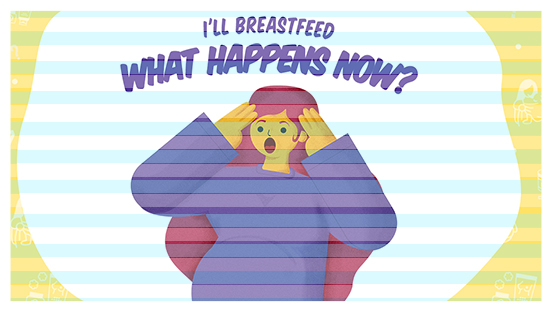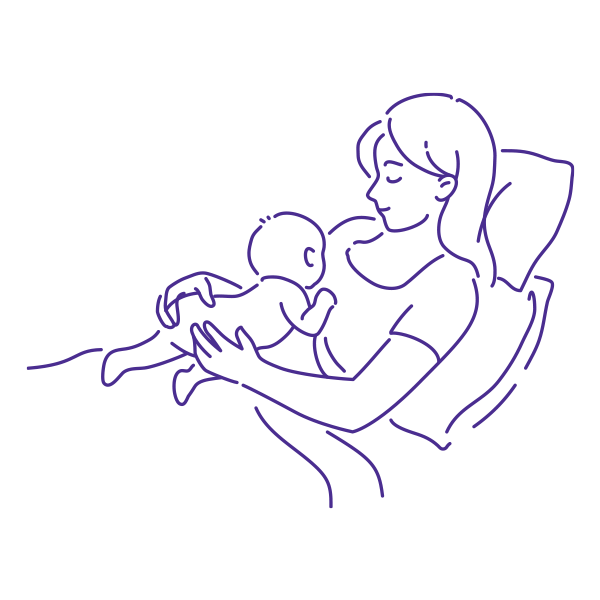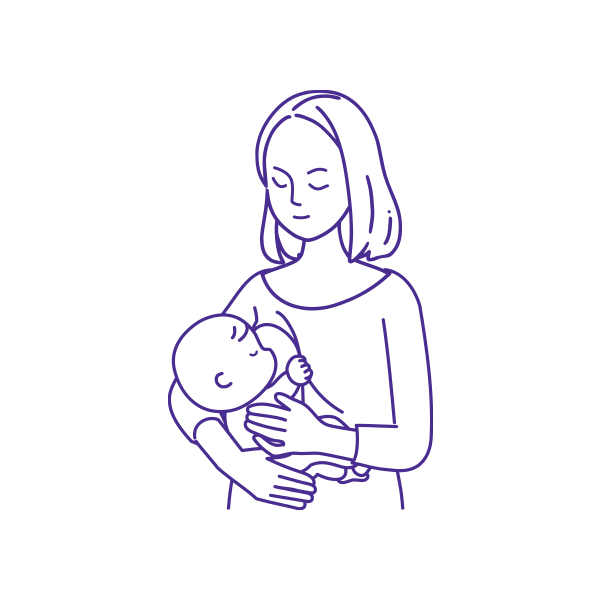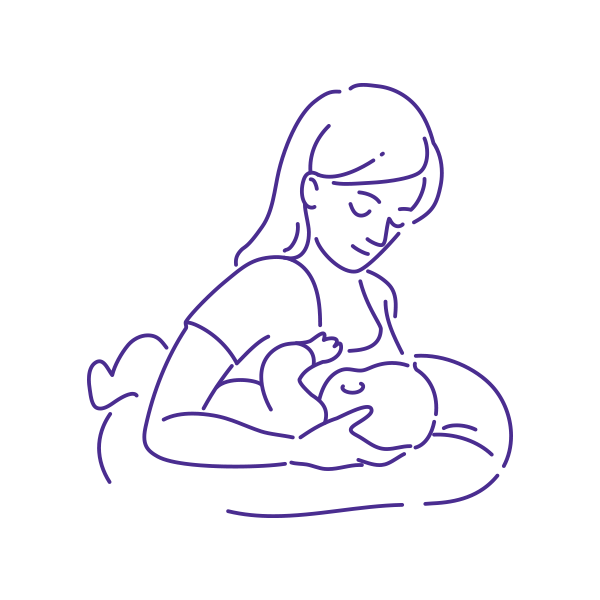Breastfeeding may not be a fairy tale you were taught.
But that doesn’t mean it won’t have a happy ending.
And since for every end there is a means, this is a practical – and unconventional – guide to help you with your journey.
Breastfeeding Guide
Like mother, like child
GOOD FOR THE MOM
Your Breastfeeding Guide already begins by teaching that breastfeeding not only benefits the baby:
: it helps prevent the mother from developing diseases such as osteoporosis, type 2 diabetes, cancer (breast, ovarian, and uterine), bleeding in the uterus, and cardiovascular diseases. It also helps with self-esteem – recovering the weight before pregnancy – and combats depression.
GOOD FOR THE BABY
- Increases the bond between mother and child
- Improves digestion and minimizes cramps
- Protects against infections and reduces mortality (children up to 5 years old)
- Prevents contagious diseases, such as diarrhea
- Reduces the risk of respiratory allergies, hypertension, high cholesterol, diabetes, and obesity
- Helps in the development of cognition (intelligence) and the oral cavity (teeth).
On top of all this, the mother’s body adapts to the baby’s needs! A baby with an infection, for example, will benefit from milk rich in defenses to fight it off.

Breastfeeding Guide
Moms who are already breastfeeding
If everything is going well, good! But you can never have too much information.
What’s more, maybe someone you know is in need too…
For that, you can rely on this Breastfeeding Guide.
WHEN & HOW MUCH
Until 6 months of age, breastfeeding should be exclusive, because milk provides for all the baby’s needs.
From 6 months on, feeding should be introduced because, by the age of 12 months, milk provides about half the energy a baby needs:
- 6th month: fruit (mashed or scraped) and first main meal (lunch or dinner)
- 7th to 8th month: second main meal (lunch or dinner)
- 9th to 11th month: gradually move on to family meals, with consistency adjustment
- 12th month: observe the appropriateness of foods eaten in the family
Until 24 months, breastfeeding can continue to be complementary, because from 12 months on, it still represents about 1/3 of the baby’s needs.
OPEN BAR?
A healthy baby breastfeeds, in average, 8 to 12 times a day.
But this is not a rule! According to the Ministry of Health and the Brazilian Society of Pediatrics (SBP), breastfeeding should be by free demand.
IF THE BABY LATCHES TO ONE, IT LATCHES TO ALL!
At the breastfeeding moment, the correct grip is very important. But it is not complex at all:
1 Open the baby’s mouth wide and cover the entire nipple so that the child’s chin touches the breast.
2 The baby’s lips should be turned outwards (little fish mouth) and the cheeks rounded (full of milk).
3 The areola should be more visible above than below the baby’s mouth, and the baby’s lower lip facing outward.
4 The sucking needs to be slow, deep, and rhythmic, and it must be possible to see and hear the swallowing of the milk.
EXTRA PTo help with the latching, place the thumb above the areola and the index finger below it, forming a “C”. Regarding nipple sensitivity, sunbathing the area for 15 minutes a day can help.
IT’S NOT A PICTURE, BUT POSING IS EVERYTHING!
A comfortable position for mother and child is essential. This makes breastfeeding easier and prevents the breast from injury and discomfort:
NO DISPUTE BETWEEN THE BREASTS!
It is normal that the milk flow is greater in one of the breasts.
The baby is smart and always gives preference to the one with the higher flow, so always offer both breasts equally.
LOVE IS NOT PAIN…
It is not normal for fissures and cracks to appear on the breasts, nor to feel pain during the act – this suggests that the baby is not latching the breast correctly.
To help, moisturize the nipple and areola by rubbing your own milk on the area.
THE MILK MUST BE SPILLED (inside the jar)!
Accumulated milk hardens and makes the breasts sore.
This occurs when the baby is unable to suck it or consumes less than is produced. Massage with circular movements, and then perform milking to store or donate the excess. And speaking about donating, did you know that “Motherly Love Also Fits in a Small Jar”? Check out the 2020 campaign and learn all about it!
LOVE THAT COMES FROM THE BREAST IS NEVER WEAK!
The final milk (when the breast is completely emptied) has a higher fat content, which makes the baby gain weight and feel satiated.
But the previous milk is also great (and indispensable), although less caloric.
The first milk that the mother produces when she starts breastfeeding is called colostrum. Thicker and yellowish, it is the ideal food for the newborn, because it plays a fundamental role in the child’s immunological development.
IF YOU DRINK, YOUR BABY DRINKS
Alcoholic beverages are not advised until the baby is at least 6 months old.
After this period, whenever you are going to breastfeed, wait until the substance is eliminated from your body: about 2 hours for each dose of alcohol (1 can of beer, 1 glass of 100 ml of wine, or 30 ml of spirits).
IF YOU SMOKE, TOO!
Your Breastfeeding Guide warns: smoking is contraindicated at any stage, even more so at this one!
In addition to tobacco damaging the production of milk and nutrients, substances from the cigarette are passed on to the baby through breastfeeding. If you breastfeed and still smoke, never exceed the 10 cigarettes/day mark.
IS NOT ENOUGH, 2 IS GOOD, 3 IS ALSO GOOD… (and so on)
Tired just imagining it, right? But relax, the body that gives birth to 2 or more babies is prepared to nourish them.
Don’t worry about the difference in “hunger” between them – this is absolutely normal – nor about the fact that they will not always breastfeed together.
Will you need help? Yes! This is why your support network is so important. And also look for groups of mothers who have breastfed multiples to gather tips and testimonials.
BREASTFEEDING & COVID-19
There is no evidence that breast milk transmits the new coronavirus.
But mothers who suspect or test positive for Covid-19 should maintain basic hygiene precautions: wash their hands and breasts (only with water) before breastfeeding, wear a mask, and avoid letting the baby touch the mother’s face, eyes, or hair.
The only evidence is that vaccinated mothers immunize their babies through breastfeeding. While we are at it, take our Mommy Quiz and clarify all your questions about breastfeeding in the midst of the pandemic.
I’M GOING BACK TO WORK, WHAT HAPPENS NOW?
If you are working from home, it’s easier.
But even if you’re not, the baby does not need to be weaned because of this. Breastfeed in the morning, late afternoon, or middle of the night. And when you are not with the baby, make small stocks of breast milk. But remember: breast milk can only be stored in the freezer for up to 15 days.
Check out our Return to Work Manual!
Breastfeeding Guide
Moms who aren’t able to do it
Breastfeeding has always been (and still is) overly romanticized, which creates a huge and harmful burden on mothers. But not here in your Breastfeeding Guide!
In general, most women are able to breastfeed, but may face initial difficulties due to practical factors, such as those in the first part of this Breastfeeding Guide (check it out if this is your case).
But it is indispensable to know that even if you can’t do it, it doesn’t make you less of a mother. Because for everything there is a way (or ways). Shall we go to it(them)?
CALL THE EXPERT
In times of fake news, don’t go around testing alternative methods.
Check with your doctor, your baby’s pediatrician, nutritionists, or lactation consultants to find out if it’s really time to give up conventional breastfeeding.
To help you with this, look for the Rede D’Or São Luiz Maternity nearest you.
MOTHERLY LOVE ALSO FITS IN A SMALL JAR
If the alternative is to resort to donation, search for a reliable milk bank.
There, the milk is treated, pasteurized, and free from any possibility of disease transmission.
Want to clear all your doubts?
Check out our campaign on the subject!
KEEP CALM & RELACTATE
An alternative for when breastfeeding is too little or not feasible is relactation:
a technique in which the baby is given formula, animal milk, or pasteurized human milk through a tube or relactation kit.
ALL MOTHERS ARE NOT THE SAME!
However well-intentioned it may be, cross-breastfeeding – when one mother breastfeeds another mother’s child – is very risky, as the baby can be contaminated with infectious diseases such as AIDS, hepatitis B, etc. – even within the family!
THE SUPPORT NETWORK
If you have never heard of the breastfeeding support network, most likely you have never needed it.
It consists of all the people, groups and institutions that support women during this phase. Whether it’s helping with the day-to-day tasks, taking care of the baby while she rests, or helping the mom with her health care, the support network is indispensable at this time of such physical and emotional demand.
Learn about the countless ways the support network works at https://dorconsultoria.com.br/portfolio/support-network/.
If you have come this far, we hope this Breastfeeding Guide has answered your questions.
But don’t forget: always consult your doctor before making any decision.
Technical Manager: Dr. Sérgio Hércules – CRM (Regional Medical Council) 61.605
Sources
https://www.unicef.org/brazil/amamentar-com-seguranca-durante-pandemia-de-covid-19
https://bebe.abril.com.br/amamentacao/duvidas-frequentes-amamentacao/
https://www.saudeaqualquerhora.com.br/blog/aleitamento-materno-as-principais-duvidas-sobre-amamentacao-respondidas-aqui
https://portal.fiocruz.br/noticia/entrevista-pediatra-explica-o-que-fazer-quando-nao-e-possivel-amamentar
https://drauziovarella.uol.com.br/mulher-2/obstetricia/principais-duvidas-sobre-amamentacao/
https://www.sbp.com.br/especiais/pediatria-para-familias/nutricao/depressao-pos-parto/
https://www.sbp.com.br/especiais/pediatria-para-familias/nutricao/rede-de-apoio-faz-diferenca-no-aleitamento-materno/
https://www.tuasaude.com/posicao-correta-para-a-amamentacao/
https://www.sbp.com.br/imprensa/detalhe/nid/sbp-recomenda-vacinacao-contra-a-covid-19-em-lactantes/
https://news.un.org/pt/story/2019/08/1682331
https://www.personare.com.br/manual-de-aleitamento-materno-2-m3495
http://casacurumim.com.br/pega-correta-para-amamentacao-evita-problemas-para-mamae-e-bebe/#:~:text=Durante%20a%20amamenta%C3%A7%C3%A3o%2C%20%C3%A9%20importante,do%20leite%20tamb%C3%A9m%20%C3%A9%20poss%C3%ADvel.
https://emais.estadao.com.br/noticias/bem-estar,amamentacao-para-gemeos-confira-dicas-e-metodos-para-facilitar-sua-rotina-com-os-bebes,70003394312









